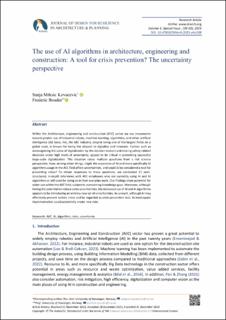| dc.contributor.author | Mrksic Kovacevic, Sanja | |
| dc.contributor.author | Bouder, Frederic Emmanuel | |
| dc.date.accessioned | 2024-04-15T12:07:09Z | |
| dc.date.available | 2024-04-15T12:07:09Z | |
| dc.date.created | 2024-01-11T22:31:07Z | |
| dc.date.issued | 2023 | |
| dc.identifier.citation | Mrksic Kovacevic, S., Bouder, F.E. (2023) The use of AI algorithms in architecture, engineering and construction: A tool for crisis prevention? The uncertainty perspective. Journal of Design for Resilience in Architecture and Planning, 4 (Special issue), 39-50. | en_US |
| dc.identifier.issn | 2757-6329 | |
| dc.identifier.uri | https://hdl.handle.net/11250/3126568 | |
| dc.description.abstract | Within the Architecture, engineering and construction (AEC) sector we see movements toward greater use of industrial robots, machine learning, algorithms, and other artificial intelligence (AI) tools. Yet, the AEC industry, despite being one of the largest fields on a global scale, is known for being the slowest to digitalize and innovate. Factors such as unrecognizing the value of digitalization by the decision-makers and making safety-related decisions under high levels of uncertainty, appear to be critical in preventing successful large-scale digitalization. This situation raises multiple questions from a risk science perspective. How, among other things, might the expansion of AI and more specifically AI algorithms usage in the AEC field affect uncertainties, and could AI be considered a tool for preventing crises? To obtain responses to these questions, we conducted 21 semi-structured, in-depth interviews with AEC employees who are currently using AI and AI algorithms or will soon be doing so in their everyday work. Our findings show potential for wider use within the AEC field, subject to overcoming knowledge gaps. Moreover, although having the potential to reduce some uncertainties, the increased use of AI and AI algorithms appears to be introducing an entirely new set of uncertainties. As a result, although AI may effectively prevent certain crises and be regarded as crisis prevention tool, its inadequate implementation could potentially create new risks. | en_US |
| dc.language.iso | eng | en_US |
| dc.publisher | Mehmet Topcu | en_US |
| dc.rights | Navngivelse 4.0 Internasjonal | * |
| dc.rights.uri | http://creativecommons.org/licenses/by/4.0/deed.no | * |
| dc.subject | KI | en_US |
| dc.subject | kunstig intelligens | en_US |
| dc.subject | AI | en_US |
| dc.subject | artificial intelligence | en_US |
| dc.subject | usikkerhet | en_US |
| dc.title | The use of AI algorithms in architecture, engineering and construction: A tool for crisis prevention? The uncertainty perspective | en_US |
| dc.type | Peer reviewed | en_US |
| dc.type | Journal article | en_US |
| dc.description.version | publishedVersion | en_US |
| dc.source.pagenumber | 39-50 | en_US |
| dc.source.volume | 4 | en_US |
| dc.source.journal | Journal of Design for Resilience in Architecture and Planning | en_US |
| dc.identifier.doi | 10.47818/DRArch.2023.v4si108 | |
| dc.identifier.cristin | 2225001 | |
| cristin.ispublished | true | |
| cristin.fulltext | original | |
| cristin.qualitycode | 1 | |

